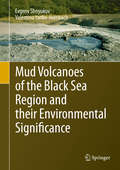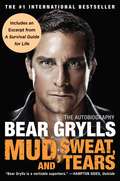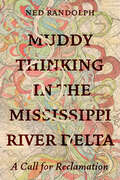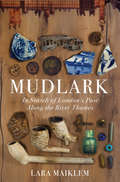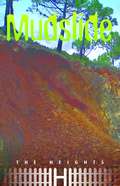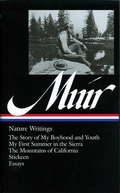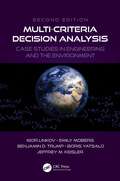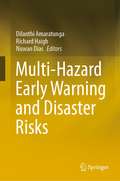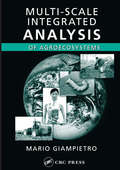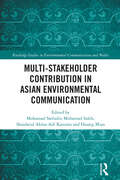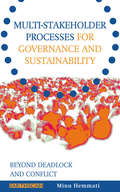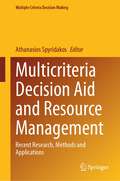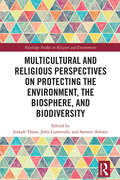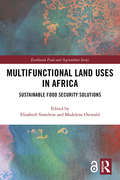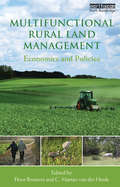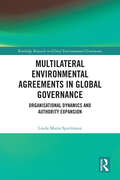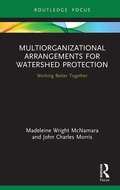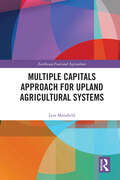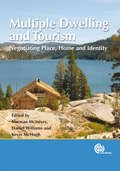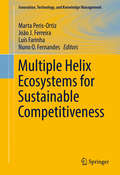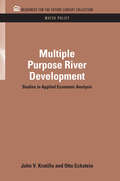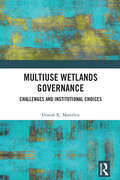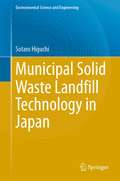- Table View
- List View
Mud Volcanoes of the Black Sea Region and their Environmental Significance
by Evgeny Shnyukov Valentina Yanko-HombachThis exceptionally well-illustrated book at a high scientific level describes mud volcanism as a complex, multidimensional phenomenon requiring multidisciplinary study. Mud volcanoes can be used as “cheap windows” to search for gas-hydrates and other mineral resources in the Black Sea region. Nothing similar has been published before, and as one of its unique features the book includes a vast amount of new data unavailable so far to the western reader. The book includes new data on driving forces, mechanisms, origin, geological and geomorphological features of mud volcanoes as well as new data on composition of solid, gaseous, and liquid components of erupted material. It covers a wide geographic region, and its subjects range from geological to environmental to industrial applications.
Mud, Sweat, and Tears: The Autobiography
by Bear Grylls“Bear Grylls is a veritable superhero….The former UK Special Forces paratrooper has braved the world’s harshest environments.” —Hampton Sides, Outside Magazine“Bear Grylls is one tough, crazy dude.” —Washington PostTHE THRILLING #1-BESTSELLING MEMOIR BY THE ADVENTURE LEGEND AND STAR OF NBC'S RUNNING WILD WITH BEAR GRYLLSBear Grylls has always sought the ultimate in adventure. Growing up on a remote island off of Britain's windswept coast, he was taught by his father to sail and climb at an early age. Inevitably, it wasn't long before the young explorer was sneaking out to lead all-night climbing expeditions.As a teenager at Eton College, Bear found his identity and purpose through both mountaineering and martial arts. These passions led him into the foothills of the mighty Himalayas and to a karate grandmaster's remote training camp in Japan, an experience that soon helped him earn a second-degree black belt. Returning home, he embarked upon the notoriously grueling selection course for the British Special Forces to join the elite Special Air Service unit 21 SAS—a journey that would push him to the very limits of physical and mental endurance.Then, disaster. Bear broke his back in three places in a horrific free-fall parachuting accident in Africa. It was touch and go whether he would walk again, according to doctors. However, only eighteen months later, a twenty-three-year-old Bear became one of the youngest climbers to scale Mount Everest, the world's highest summit. But this was just the beginning of his many extraordinary adventures. . . .Known and admired by millions as the star of Man vs. Wild, Bear Grylls has survived where few would dare to go. Now, for the first time, Bear tells the story of his action-packed life. Gripping, moving, and wildly exhilarating, Mud, Sweat, and Tears is a must-read for adrenaline junkies and armchair explorers alike.
Muddy Thinking in the Mississippi River Delta: A Call for Reclamation
by Ned RandolphA free ebook version of this title is available through Luminos, University of California Press's Open Access publishing program. Visit www.luminosoa.org to learn more.Muddy Thinking in the Mississippi River Delta uses the story of mud to answer a deceptively simple question: How can a place uniquely vulnerable to sea level rise be one of the nation's most promiscuous producers and consumers of fossil fuels? Organized around New Orleans and South Louisiana as a case study, this book examines how the unruly Mississippi River and its muddy delta shaped the people, culture, and governance of the region. It proposes a framework of "muddy thinking" to gum the wheels of extractive capitalism and pollution that have brought us to the precipice of planetary collapse. Muddy Thinking calls upon our dirty, shared histories to address urgent questions of mutual survival and care in a rapidly changing world.
Mudlark: In Search Of London's Past Along The River Thames
by Lara Maiklem“Engrossing . . . evokes the subculture of the ‘mudlarks,’ who scour the banks for fragments of London’s past.”—The New Yorker The international bestseller that mesmerizingly charts quixotic journeys through London’s past, Mudlark thrills Anglophiles and history lovers alike. Long heralded as a city treasure herself, beloved “Mudlark” Lara Maiklem tirelessly treks along the Thames’ muddy shores, unearthing a myriad of artifacts and their stories—from Roman hairpins and perfectly preserved Tudor shoes to the clay pipes that were smoked in riverside taverns. Seamlessly interweaving reflections from her own life with meditations on the art of wandering, Maiklem ultimately delivers a treatise “as deep and as rich as the Thames and its treasures” (Stanley Tucci).
Mudslide
by Saddleback Educational PublishingThemes: Hi-Lo, Family life, adventure, travel. These traditional reads are brimming with spirited characters and positive values--but with a little extra excitement and bite, so hold on to your hats! Written expressly for the middle grade struggling reader, the series does not contain strong language, edgy themes, or dysfunctional families. In fact, family is the main theme of these titles. And one particular Latino family is the focus with their uncanny knack for finding humor, hope, and colorful personalities--even in unusual circumstances. Written at the lowest reading levels, the 50-page story structure is straightforward and moves the reader through the text quickly and efficiently. "Mom? Mom! Can you hear me?" Lilia cried. But there was no answer. The only sound Lilia could hear were pebbles rolling down the mountain.
Muir: Nature Writings
by John Muir William CrononIn a lifetime of exploration, writing, and passionate political activism, John Muir made himself America's most eloquent spokesman for the mystery and majesty of the wilderness. A crucial figure in the creation of our national parks system and a visionary prophet of environmental awareness, he was also a master of natural description who evoked with unique power and intimacy the untrammeled landscapes of the American West. Nature Writings collects his most significant and best-loved works in a single volume. The Story of My Boyhood and Youth (1913) is Muir's account of growing up by the sea in Scotland, of coming to America with his family at age eleven, and of his early fascination with the natural world. My First Summer in the Sierra (1911) is his famous account of the spiritual awakening he experienced when, 1869, he first encountered the mountains and valleys of central California. The Mountains of California (1894) draws on half a lifetime of exploration of the high Sierra country to celebrate and evoke the region's lakes, forests, flowers, and animals in a masterpiece of observation and poetic description. Also included are the widely popular "Stickeen" (1909), Muir's affectionate story of an adventure with a dog in Alaska, and a rich selection of essays - including "Yosemite Glaciers", "God's First Temples", "Snow-Storm on Mount Shasta", "The American Forests", and the late appeal "Save the Redwoods" - highlighting various aspects of his career: his exploration of what became Yosemite and Yellowstone national parks and the Grand Canyon, his successful crusades to preserve the wilderness, his early walking tour to Florida, and the Alaska journey of 1879.
Multi-Criteria Decision Analysis: Case Studies in Engineering and the Environment (Environmental Assessment and Management)
by Jeffrey M. Keisler Igor Linkov Benjamin D. Trump Emily Moberg Boris YatsaloDecision analysis has become widely recognized as an important process for translating science into management actions. With climate change and other systemic threats as driving forces in creating environmental and engineering problems, there is a great need for understanding decision making frameworks through a case-study based approach. Management of environmental and engineering projects is often complicated and multidisciplinary in scope and nature, thus issues that arise can be difficult to solve analytically. Multi-Criteria Decision Analysis: Case Studies in Engineering and the Environment provides detailed description of MCDA methods and tools and illustrates their applications through case studies focused on sustainability and system engineering applications. New in the Second Edition: Addresses current and emerging environmental and engineering problems Includes seven new case studies to illustrate different management situations applicable at the international level Builds on real case studies from recent and relevant environmental and engineering management experience Describes advanced MCDA techniques and extensions used by practitioners Provides corresponding decision models implemented using the DECERNS software package Gives a more holistic approach to teaching MCDA methodology with a focus on sustainable solutions and adoption of new technologies, including nanotechnology and synthetic biology Given the novelty and inherent applicability of this decision-making framework to the environmental and engineering fields, a greater number of teaching tools for this topic need to be made available. This book provides those teaching tools, covering the breadth of the applications of MCDA methodologies with clear explanations of the MCDA process. The case studies are implemented in the DECERNS software package, allowing readers to experiment and explore and to understand the full process by which environmental managers assess these problems. This book is a great resource for professionals and students seeking to learn decision analysis techniques and apply similar frameworks to environmental and engineering projects
Multi-Hazard Early Warning and Disaster Risks
by Dilanthi Amaratunga Richard Haigh Nuwan DiasThis book presents a collection of papers under the theme of multi-hazard early warning and disaster risks. These were selected from the presentations made at the International Symposium on Tsunami and Multi-Hazard Risks, Early Warning and Community Awareness in supporting implementation of the Sendai Framework for Disaster Risk Reduction 2015-2030. This conference aimed to recognize achievements and to highlight work that still needs to be carried out. The conference promoted collaboration among academia, research institutions and disaster management offices, and further encouraged multidisciplinary and multi-sectoral interactionThis International Symposium on Multi-Hazard Early Warning and Disaster Risk Reduction provided an important opportunity to reflect upon our progress to date in tackling disaster risk, but also to consider some of the challenges and opportunities that lay ahead of us.A particular focus of this event wasMulti-Hazard Early Warning. During the negotiations for the Sendai Framework, countries and partners highlighted the need to:1. Continue to invest in, develop, maintain and strengthen people-centred, end-to-end early warning systems;2. Promote the application of simple and low cost early warning equipment and facilities;3. Broaden the dissemination channels for early warning information to facilitate early action.Countries also called for the further development of and investment in effective, nationally compatible, regional multi-hazard early warning mechanisms. To address these needs, global Target (g) of the Sendai Framework was adopted, namely to “substantially increase the availability of and access to multi-hazard early warning systems and disaster risk information and assessments to the people by 2030”. As illustrated by recent events in Indonesia, it is also vital to address the challenge of cascading hazards that pose a tsunami risk, and the importance of linking tsunami early warning to a multi-hazard environment. However, moving towards a multi-hazard environment is complex and poses many challenges but can bring significant benefits in terms of efficiencies and also in recognising the links between hazards, such as cascading threats. We very much hope that this book will provide an important platform to address these and other challenges in addressing disaster risk, as well as supporting implementation of the Sendai Framework for Disaster Risk Reduction
Multi-Scale Integrated Analysis of Agroecosystems (Advances In Agroecology Ser.)
by Mario GiampietroEcologists, agronomists, and others who may question the validity of current models for determining sustainable growth of agroecosystems, need a new set of analytical tools that more effectively address the complex nature of related processes. Those who challenge traditional assumptions of optimization and static factors in agricultural modeling de
Multi-Stakeholder Contribution in Asian Environmental Communication (Routledge Studies in Environmental Communication and Media)
by Huang Miao Mohamad Saifudin Mohamad Saleh Shaidatul Akma Adi KasumaMulti-Stakeholder Contribution in Asian Environmental Communication focuses on how diverse actors can come together to promote sustainable environmental practices.Bringing together 25 environmental communication scholars and practitioners across 15 innovative chapters, this book explores the dynamic roles of stakeholders – ranging from governmental bodies and non-profit organisations to local communities and industry players – involved in advancing environmental communication across the Asian continent. Drawing on a rich tapestry of case studies and interdisciplinary perspectives, the book sheds light on the interplay of religious, cultural, political, and economic factors that shape environmental communication strategies and public perception in Malaysia, Indonesia, Bangladesh, China, Thailand, Iran, Japan, and Pakistan. It probes into contemporary issues such as Islamic environmental communication, gender roles, social media, political communication, the role of games and gaming companies, as well as the portrayal of ecological messages in film. Overall, this book aims to bridge the gap between theory and practice and will make a significant contribution to the growing literature on multi-stakeholder contribution in environmental communication, particularly in the Asian context.This volume will be of great interest to practitioners, policymakers, and researchers working in the field of environmental communication.
Multi-stakeholder Processes for Governance and Sustainability: Beyond Deadlock and Conflict
by Minu HemmatiGovernments, business, international bodies and local groups are turning to multi-stakeholder processes to find practical ways forward. This book explains how MSPs can be organized to deliver their potential for successful resolution of complex issues and for sustainable development. It includes detailed examples and provides practical checklists, explaining how to get beyond adversarial politics and achieve positive results.
Multicriteria Decision Aid and Resource Management: Recent Research, Methods and Applications (Multiple Criteria Decision Making)
by Athanasios SpyridakosThis book is focused on the application of methodological approaches and systems of multiple criteria decision analysis (MCDA) in the field of resource management. Resource management constitutes a major challenge of modern times. The book comprehensively examines cases of human resources, material resources and natural resources in particular. It focuses on the efficient utilization of these resources to achieve sustainability of economic, environmental and social aspects. Also, the book presents methodological tools which aim to support the decision making at operational, executive and strategic levels.The book presents recent results of scientific research in the field of MCDA and its applications to resource management. It investigates the resource management challenges and introduces innovative methodological approaches and systems for addressing these resources management issues.
Multicultural and Religious Perspectives on Protecting the Environment, the Biosphere, and Biodiversity (Routledge Studies in Religion and Environment)
by Joseph Tham John Lunstroth Sameer AdvaniThis thought-provoking volume unites bioethics experts from seven major world religions—Buddhism, Christianity, Confucianism, Daoism, Hinduism, Islam, and Judaism—alongside secular thinkers to explore environmental protection through the lens of the UNESCO Declaration on Bioethics and Human Rights. It foregrounds the power of diverse perspectives in addressing one of humanity's most pressing challenges—the ecological crisis. The contributions provide rich and distinct religious and cultural viewpoints as they confront the anthropological, ethical and social dimensions of this crisis. Showcasing dialogue where traditions and philosophies collide, they offer unique insights into global bioethics and human rights that should inspire new ways of thinking and foster meaningful collaboration in the fight for our planet's future. The book is valuable reading for researchers, scholars and students in bioethics, environmental ethics, religious studies and beyond.
Multifunctional Land Uses in Africa: Sustainable Food Security Solutions (Earthscan Food and Agriculture)
by Elisabeth Simelton Madelene OstwaldThis book presents contemporary case studies of land use, management practices, and innovation in Africa with a view to exploring how multifunctional land uses can alleviate food insecurity and poverty. Food security and livelihoods in Africa face multiple challenges in the form of feeding a growing population on declining land areas under the impacts of climate change. The overall question is what kind of farming systems can provide resilient livelihoods? This volume presents a selection of existing farming systems that demonstrate how more efficient use of land and natural resources, labour and other inputs can have positive effects on household food security and livelihoods. It examines how aquaculture, integrated water management, peri-urban farming systems, climate-smart agriculture practices and parkland agroforestry contribute multiple benefits. Drawing on case studies from Kenya, Ethiopia, Nigeria and Burkina Faso, contributed by young African scientists, this book provides a unique perspective on multifunctional land use in Africa and illustrates how non-conventional uses can be profitable while promoting social and environmental sustainability. Tapping into the global discussion on land scarcity and linking food security to existing land use change processes, this volume will stimulate readers looking for diversified land uses that are compatible with both household and national food security ambitions. This book will be of great interest to students and scholars of African development, agriculture, food security, land use and environmental management, as well as sustainable development more generally, in addition to policymakers and practitioners working in these areas.
Multifunctional Rural Land Management: Economics and Policies
by C. Martijn van der Heide Brouwer FloorThe increasing demand for rural land and its natural resources is creating competition and conflicts. Many interested parties, including farmers, nature conservationists, rural residents and tourists, compete for the same space. Especially in densely populated areas, agriculture, recreation, urban and suburban growth and infrastructure development exert a constant pressure on rural areas. Because land is a finite resource, spatial policies which are formulated and implemented to increase the area allocated to one use imply a decrease in land available for other uses. As a result, at many locations, multi-purpose land use is becoming increasingly important. This notion of multi-purpose land use is reflected in the term 'multifunctionality'. This volume provides insights into viable strategies of sustainable management practices allowing multiple functions sustained by agriculture and natural resources in rural areas. It shows how the rural economy and policies can balance and cope with these competing demands and includes numerous case studies from Europe, North America and developing countries.
Multilateral Environmental Agreements
by Bharat H. DesaiThe present study seeks to examine the genesis, development, and proliferation of multilateral environmental agreements (MEAs) - in-built law-making mechanisms and processes of institutionalization - and their ad hoc treaty-based status and the issue of the legal personality of their secretariats. It provides legal understanding of the location of MEA secretariats within an existing international host institution, as well as discussion of the issue of relationship agreements and interpretation of the commonly used language that triggers such relationships. It places under scrutiny the standard MEA phrase "providing a secretariat," delegation of authority by the host institution to the head of the convention secretariat, possible conflict areas, host country agreement, and the workings of the relationship agreements. The book offers an authoritative account of the growing phenomenon in which an existing international institution provides a servicing base for MEA that, in turn, triggers a chain of legal implications involving the secretariat, the host institution, and the host country.
Multilateral Environmental Agreements in Global Governance: Organisational Dynamics and Authority Expansion (Routledge Research in Global Environmental Governance)
by Linda Maria SpielmannThis book proposes a conceptualisation of Multilateral Environmental Agreements as a form of International Organisations, exploring the ways in which they have expanded over time by discussing the nuances of authority in global governance.Multilateral Environmental Agreements are the key type of cooperation between states to address environmental concerns globally. While their activities regularly attract much attention from an academic and non-academic audience, their peculiar hybrid nature in-between treaties and full-fledged International Organisations, means they are often underestimated. This book proposes a new and innovative conceptualisation of Multilateral Environmental Agreements as a specific type of International Organisation which allows for a more accurate understanding of their dynamic nature, and uncovers expansive tendencies which have so far gone almost completely unnoticed. Based on a modern understanding of authority in global governance, the book shows how Multilateral Environmental Agreements represent a separate entity, and expand beyond the boundaries originally set by their member states. The book draws upon the neo-functionalist concept of spillover, as well as multiple other theoretical frameworks, to identify the two main drivers of expansion in Multilateral Environmental Agreements. To illustrate these drivers, the empirical chapters conduct six structured case studies, analysing specific cases of authority expansion in ozone and climate protection, including the Green Climate Fund under the UN Framework Convention on Climate Change. Overall, this book offers an invaluable contribution to the theoretical discussion on informal types of organisations, and provides new and extensive empirical insights into unexpected past and recent developments in global environmental governance.As such, this book will be of great interest to students and scholars of International Relations and International Law who focus on informal types of cooperation and legislation, dynamic institutional development, and international environmental politics generally.
Multilevel Governance of Global Environmental Change
by Gerd WinterOriginally published in 2006, this collection is the outcome of an interdisciplinary research project involving scholars in the fields of international and comparative environmental law, the sociology and politics of global governance, and the scientific study of global climate change. Earth system analysis as developed by the natural sciences is transferred to the analysis of institutions of global environmental change. Rather than one overarching supranational organisation, a system of 'multilevel' institutions is advocated. The book examines the proper role of industrial self-regulation, of horizontal transfer of national policies, of regional integration, and of improved coordination between international environmental organisations, as well as basic principles for sustainable use of resources. Addressing both academics and politicians, this book will stimulate the debate about the means of improving global governance.
Multiorganizational Arrangements for Watershed Protection: Working Better Together (Routledge Research in Public Administration and Public Policy)
by Madeleine Wright McNamara John Charles MorrisWith cross-pollination of the public administration and policy implementation literatures, Madeleine Wright McNamara and John Charles Morris present the Multiorganizational Interaction Model as a framework to explore the use of cooperation, coordination, and collaboration between 15 federal/state agencies, local governments, and nongovernmental organizations working together to restore coastal habitats and replenish aquatic resources on Virginia’s Eastern Shore. Content analysis of data collected through interviews and organizational documents allows comparisons to be made regarding the distribution of data across the continuum of interaction. The presence of policy mandates intending to prescribe relationships coupled with strong perceptions of collaboration, create opportunity to explore mandated and voluntary collaboration. Themes regarding mapping relationships within the multiorganizational arrangement, movement on the continuum, and implementation through mid-level personnel are discussed. The combination of theory development and testing provides readers with a theoretical framework through which to think about interorganizational interactions, and a case study to illustrate the ways in which these complex relationships manifest themselves in practice. Multiorganizational Arrangements for Watershed Protection will be essential for scholars, students, and policy makers.
Multiple Capitals Approach for Upland Agricultural Systems (Earthscan Food and Agriculture)
by Lois MansfieldThis book focuses on upland agricultural systems and applies a multiple capitals approach to explain what they can provide at a time when many are struggling to survive.Marginal upland agricultural systems have been distorted and derailed by modern economics, politics, and the drive to intensification. This book argues for the application of a multiple capitals approach to resource management challenges for marginal upland agricultural communities. Instead of considering what upland agricultural systems lack, the book showcases how a multiple capitals framework can demonstrate the importance, interrelationships, and relevance of the suite of capitals (natural, human, social, cultural, and financial) to achieve better outcomes for upland communities, broader ecosystem services, and wider society more generally. It is designed to connect theory to practice to provide underpinning knowledge and guidance to help upland agricultural communities thrive. Drawing on case studies from the UK and Japan, as well as making comparisons with Central and South American countries, the book recommends tools for monitoring different forms of capital and suggests a management process driven by multiple capitals to create resilience in upland agricultural systems.This book will be of great interest to students and scholars of agriculture, natural resource management, ecosystem services, rural development, and those interested in applying a multiple capitals approach more widely within policy and landscape management contexts.
Multiple Dwelling and Tourism: Negotiating Place, Home and Identity
by Norman Mcintyre Daniel R. Williams Kevin E. MchughThe movement of people, goods, capital and information is a central aspect of living in the inter-connected, globalised late-modern world. Although this broader view of mobility is recognized, this book focuses mainly on migration or the movement of people and examines multiple dwelling as a societal response to the major influences of increased mobility and amenity tourism.
Multiple Helix Ecosystems for Sustainable Competitiveness
by Marta Peris-Ortiz João J. Ferreira Luís Farinha Nuno O. FernandesThis book discusses the main issues, challenges, opportunities, andtrends involving the interactions between academia, industry, government and society. Specifically, it aims to explore how these interactions enhance the ways inwhich companies deliver products and services in order to achieve sustainablecompetitiveness in the marketplace. Sustainable competitiveness has been widely discussed by academics andpractitioners, considering the importance of protecting the environment whilesustaining the economic goals of organizations. The Quintuple Helix innovation modelis a framework for facilitating knowledge, innovation and sustainablecompetitive advantage. It embeds the Triple and the Quadruple Helix models byadding a fifth helix, the "natural environment. " The Triple Helix model focuseson the university-industry-government triad, while the Quadruple adds civilsociety (the media- and culture-driven public) as a fourth helix. The Quintuple Helix model facilitates research, public policy, andpractical application of sustainable competitiveness principles. Applying themost recent developments and theoretical insights of this model, thecontributors to this volume address such questions as: how do government,academia, industry and civil society actors interact for promoting sustainablecompetitiveness at the country (regional) level? How do these actors influencesustainable operations management at the company (business) level? In so doing,they shed new light on the dynamics of economic growth, sustainability andcompetitiveness.
Multiple Purpose River Development: Studies in Applied Economic Analysis (RFF Water Policy Set)
by John V. Krutilla Otto EcksteinThis book sketches out a framework for analyzing the economic efficiency of particular river basin programs. It provides a useful cross-disciplinary perspective for economists and water resource developers-especially designed to provide working material for students in applied economics for conservation curricula. Originally published in 1958.
Multiuse Wetlands Governance: Challenges and Institutional Choices
by Dinesh K. MarothiaThe Ramsar Convention was established in 1971 to ensure the conservation and wise use of wetlands across the world. India joined the Convention in 1982, however, in the past 50 years despite Ramsar’s incredible achievements, the threat to wetlands across the globe, including India, has not diminished. This book studies the governance of multiuse wetlands in India. The volume provides an exhaustive analysis of rural, peri-urban and urban human-made wetlands to establish the relevance of institutional design and the effective role of authority in governing multiuse wetland ecosystem services. The author argues that the most challenging task in governing wetlands is to frame institutional choices that users and non-users comprehend, and agree to pursue under alternative property rights regimes. Drawing on extensive fieldwork, the book provides a broader look into the causes and consequences of wetland ecosystem degradation and offers insights into improved sustainable management systems for different types of multiuse wetlands. It will be indispensable for students and researchers of environmental studies, sustainable development, biodiversity, conservation, agricultural, natural, and environmental resource economics.
Municipal Solid Waste Landfill Technology in Japan (Environmental Science and Engineering)
by Sotaro HiguchiJapan was ahead of the rest of the world when it introduced intermediate processing of municipal waste by such means as incineration in the 1960s. Owing to the small land area of the country and the difficulty in securing landfill sites, the incineration ratio of municipal combustible waste had reached 100% by the 1990s. Along with the landfill of incineration residues, proprietary technologies such as high salt leachate treatment, desalination treatment, by-product recycling, a focus on the resource of incineration residues, sea surface landfill sites, and covered type landfill sites have spread and developed since then. This book describes the introduction of incineration facilities starting in the 1960s, landfill technology, and issues arising after 1990 following the introduction of the facilities. The necessity of a total system from incineration to landfill is explained as well. The volume is a valuable resource for countries that plan to introduce intermediate processing such as incineration and for countries that are developing a waste management policy.
